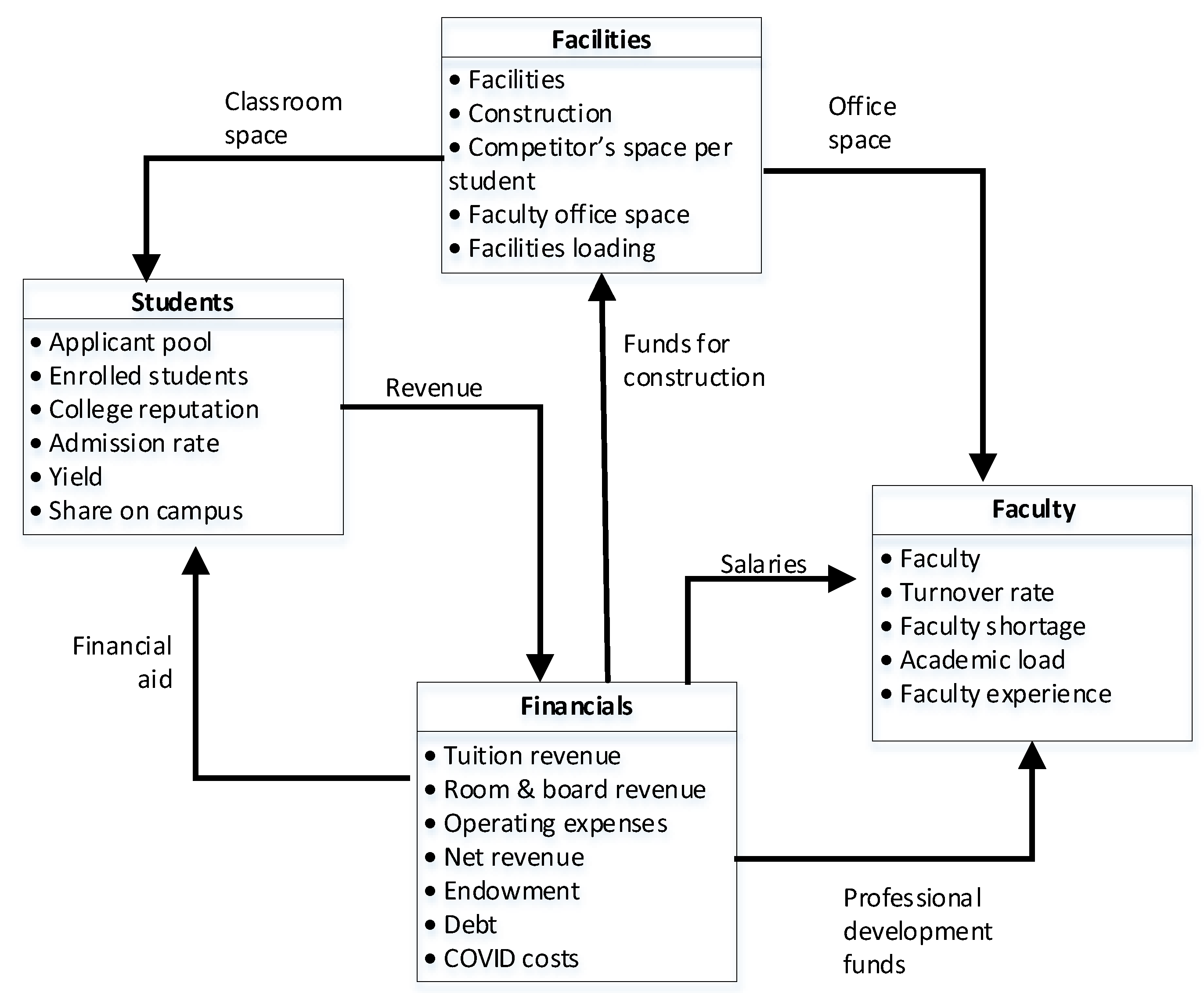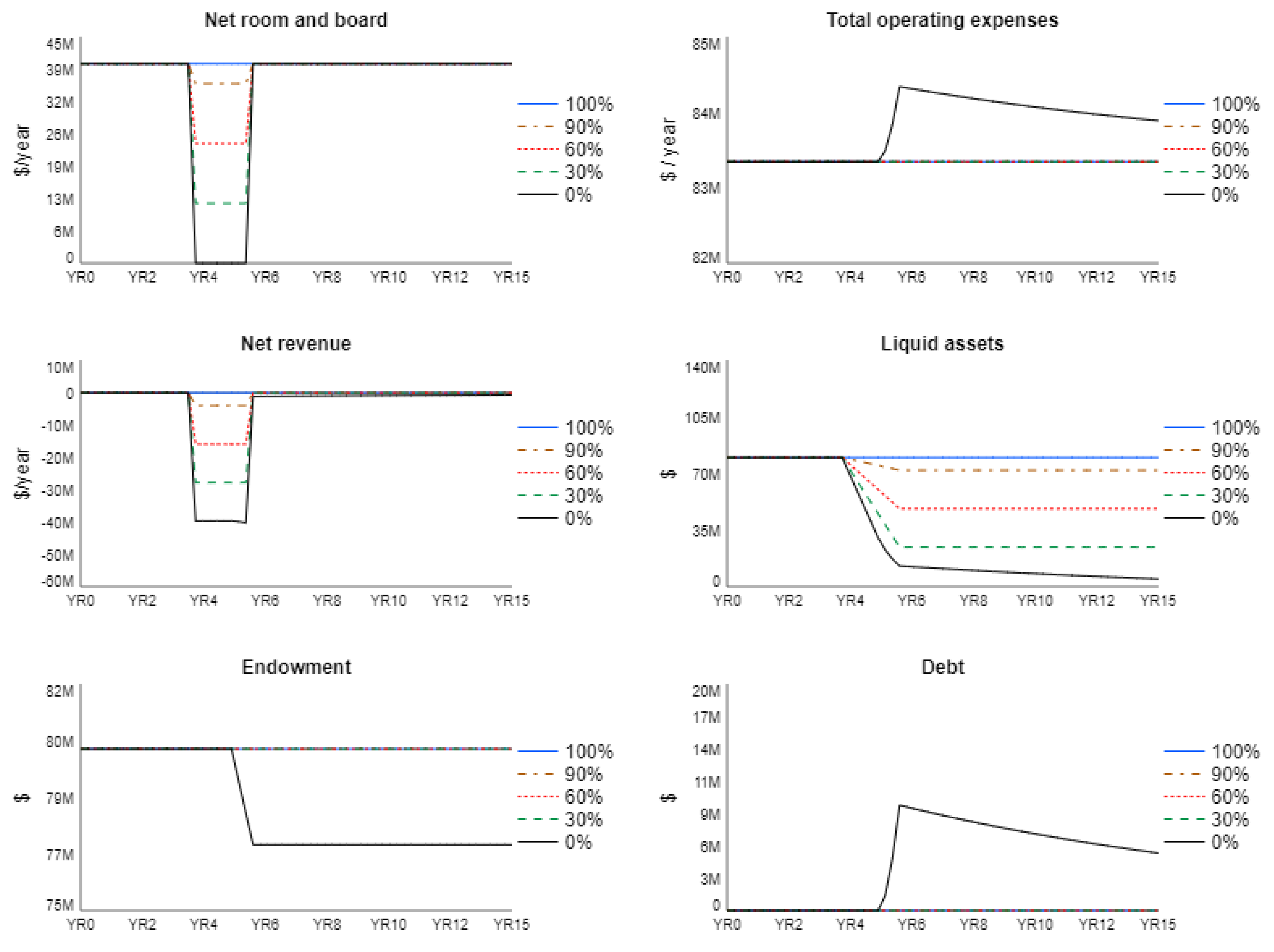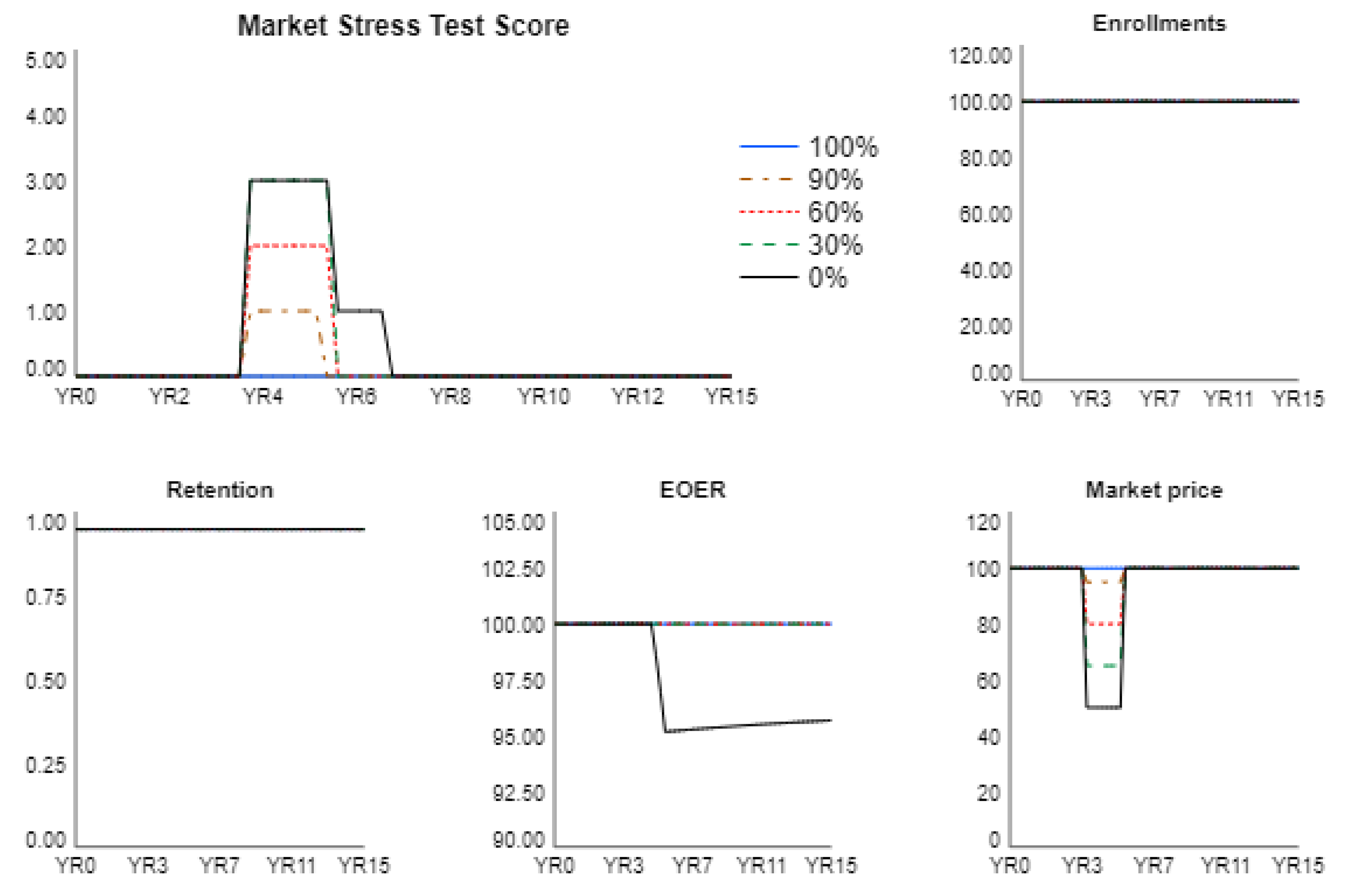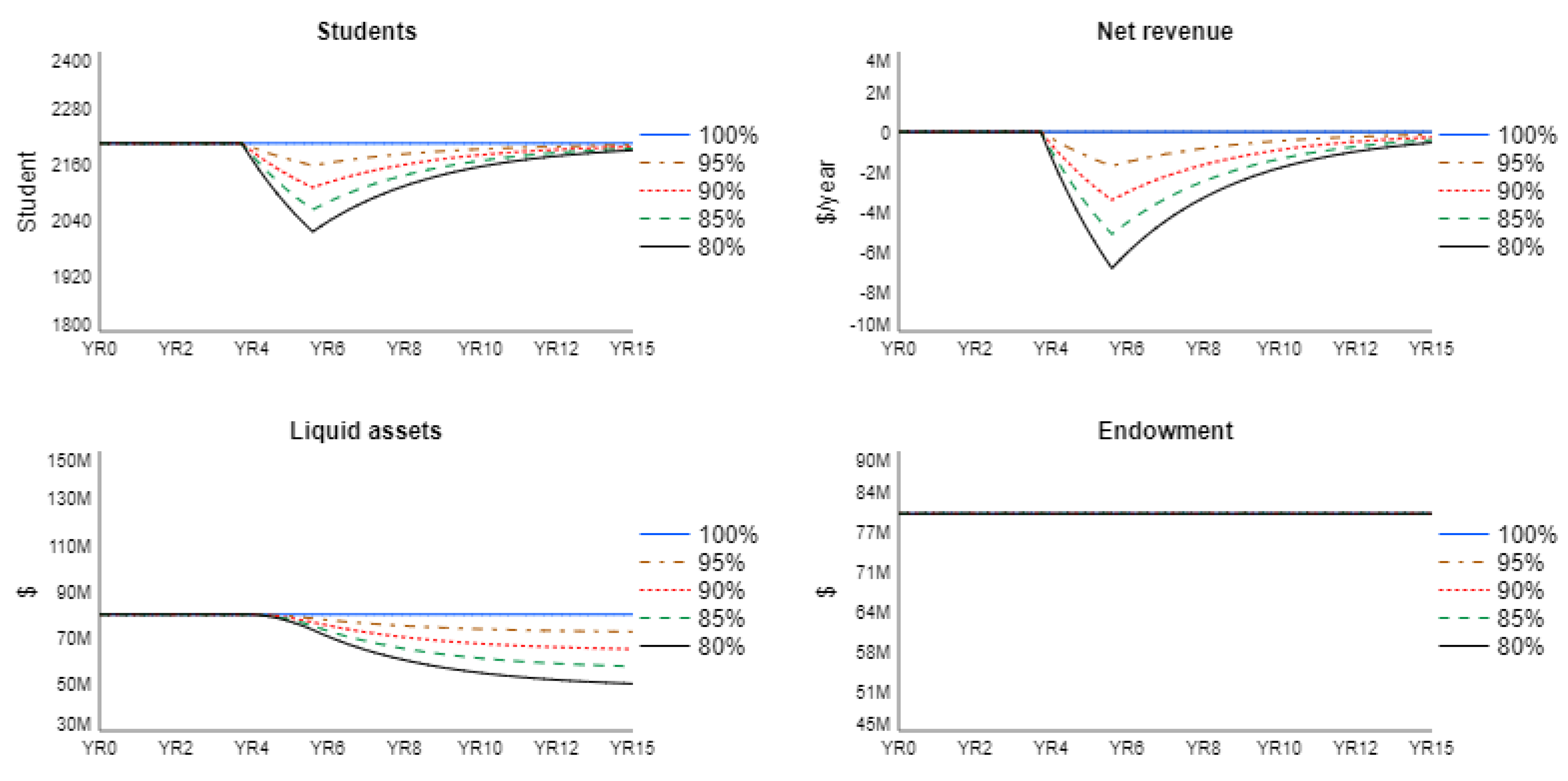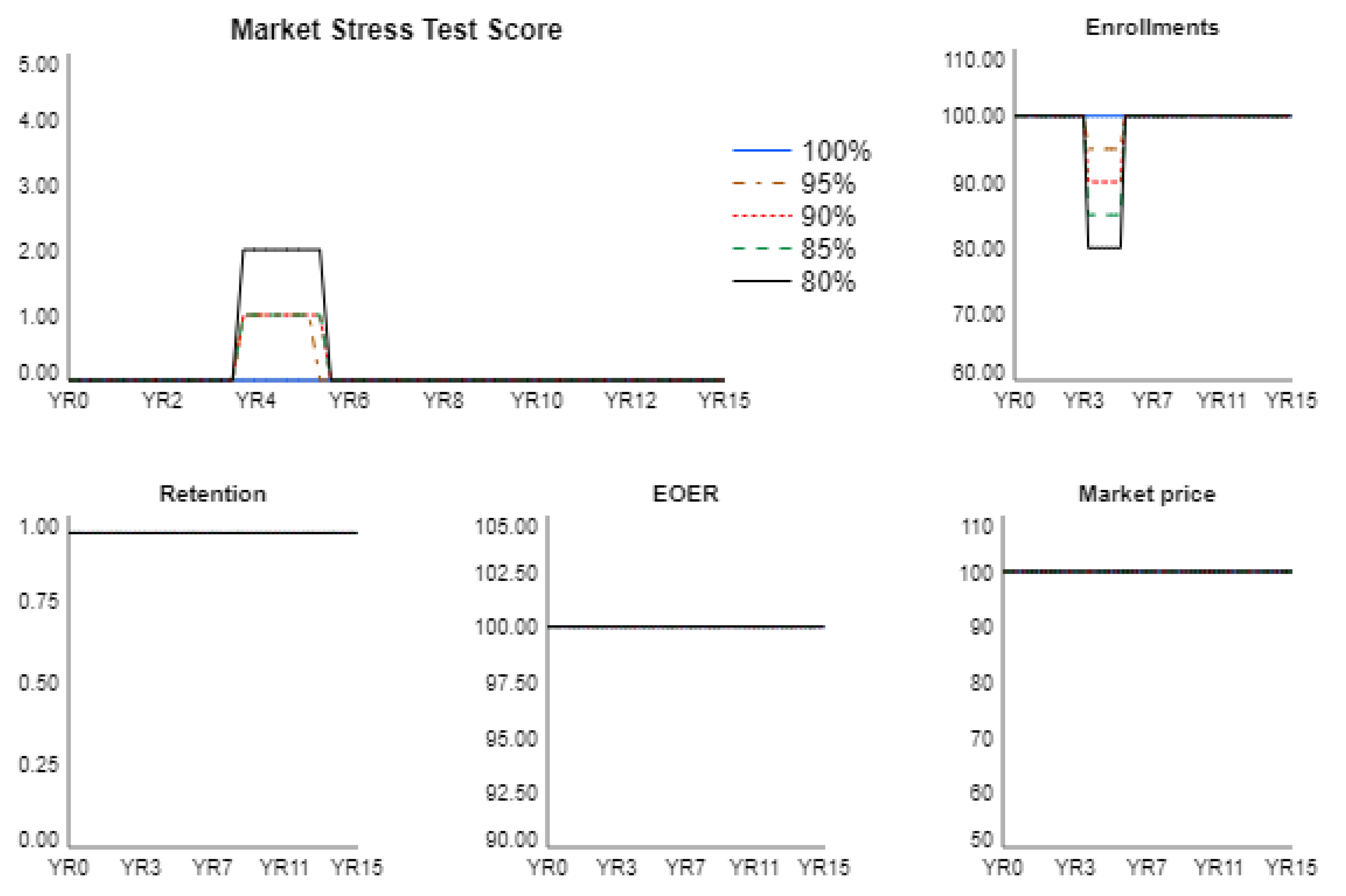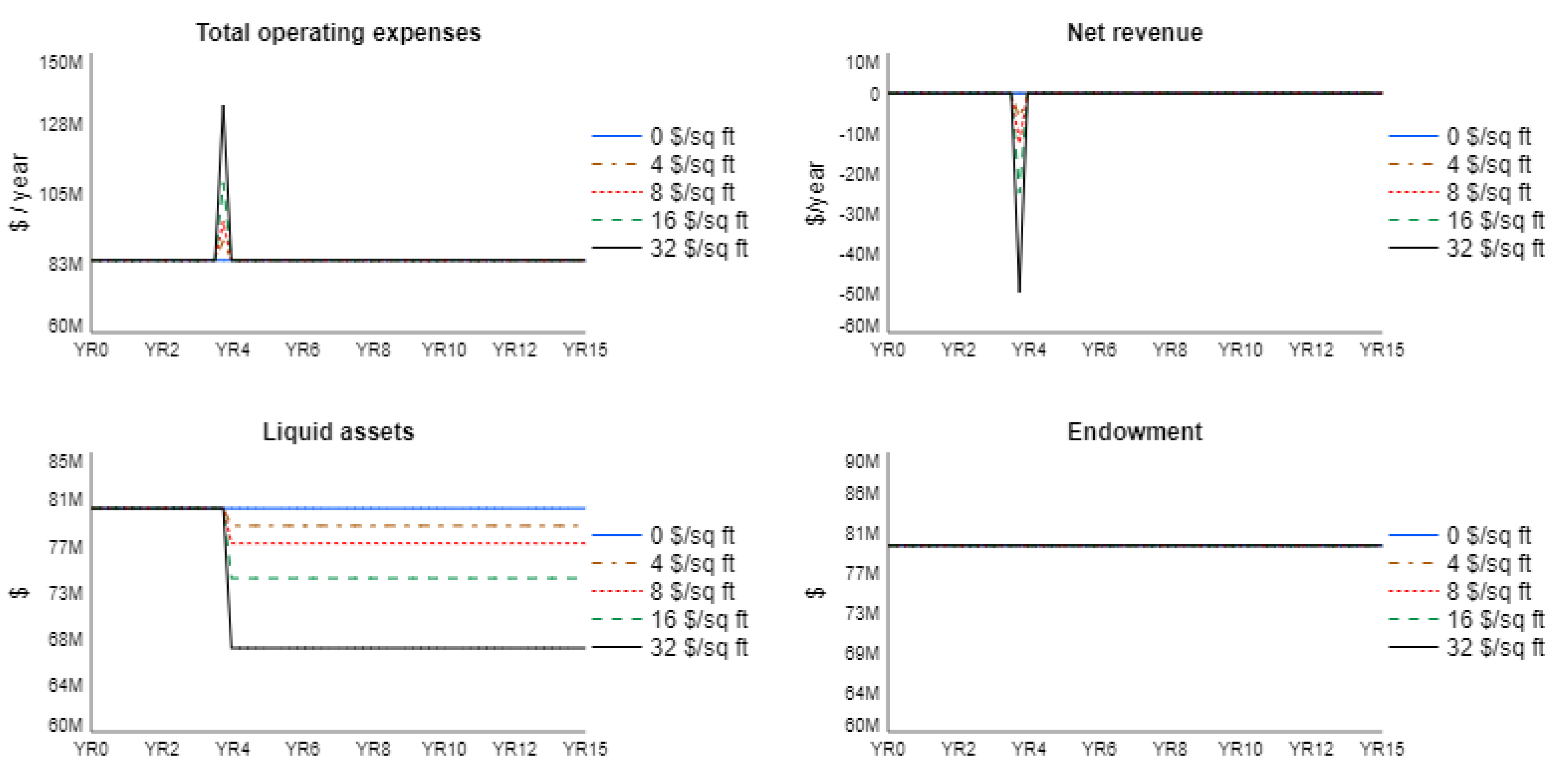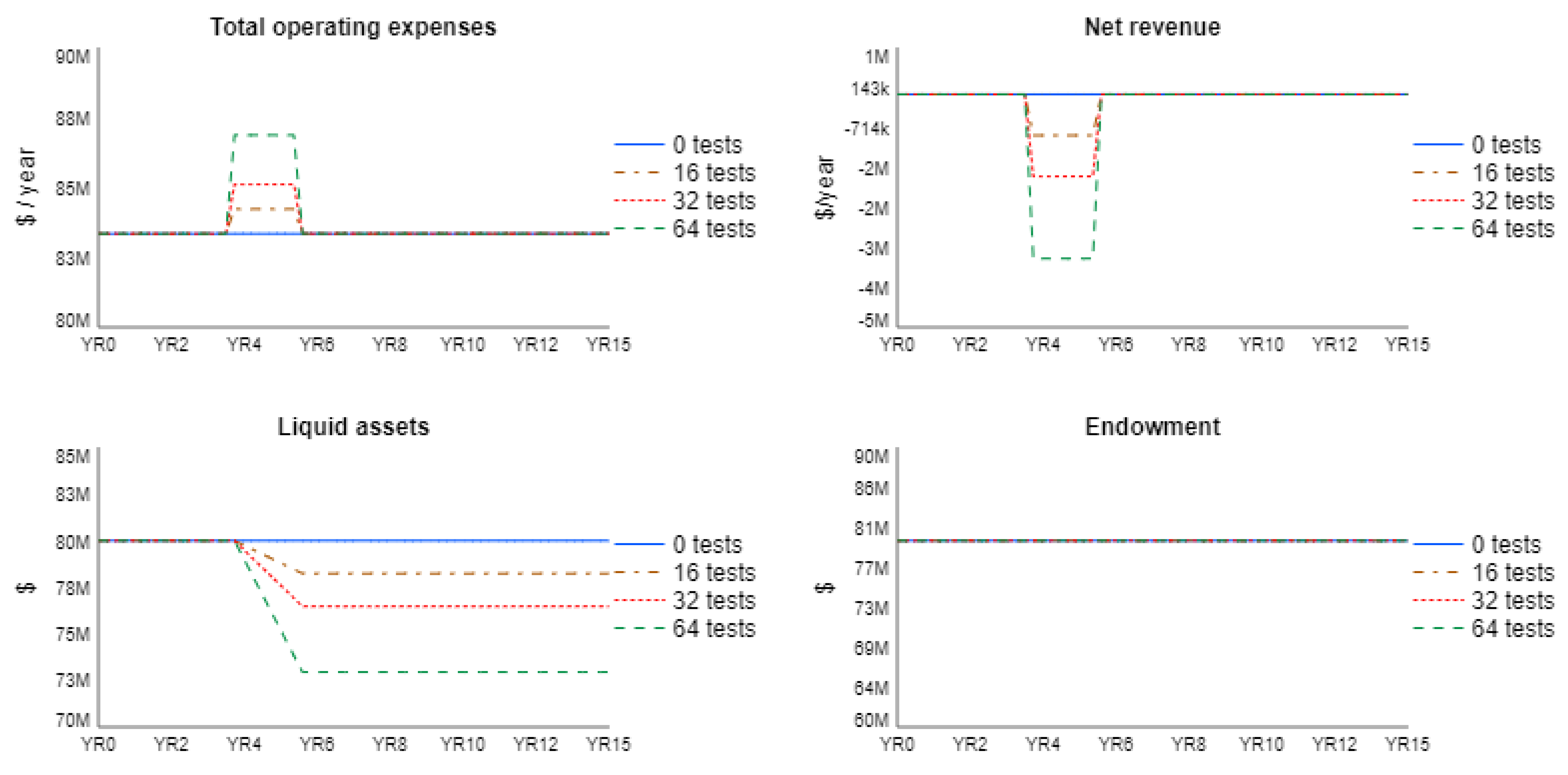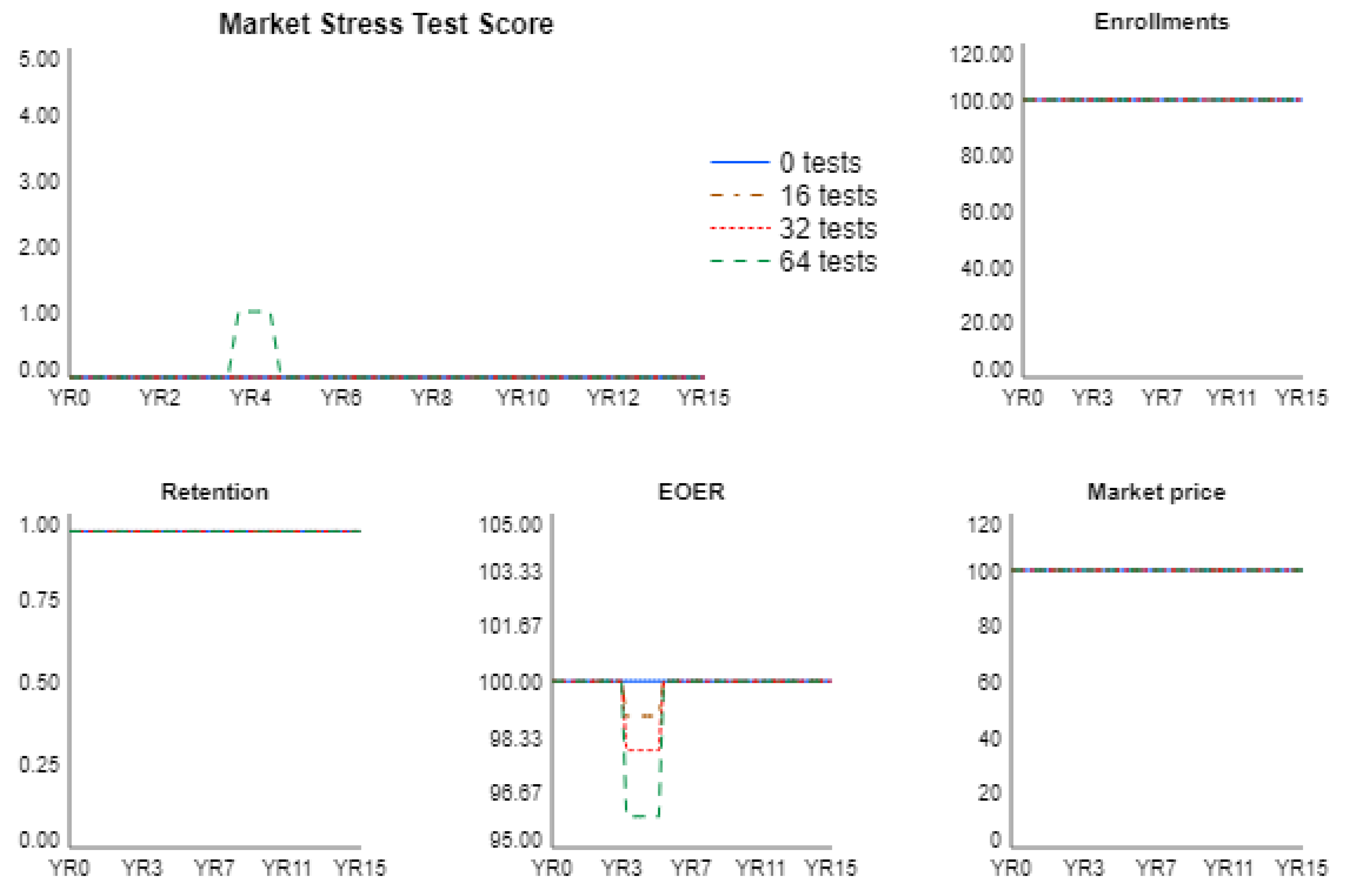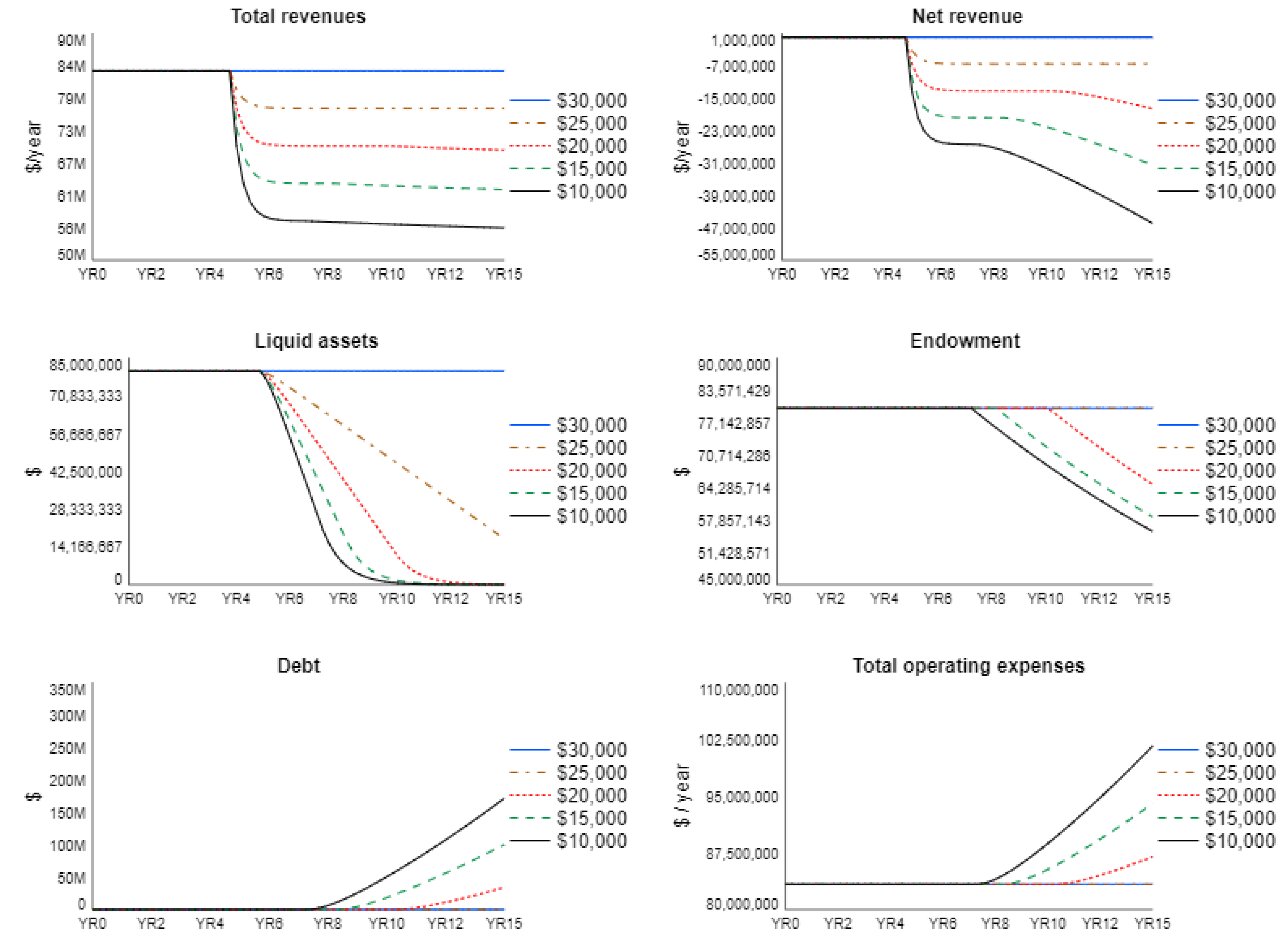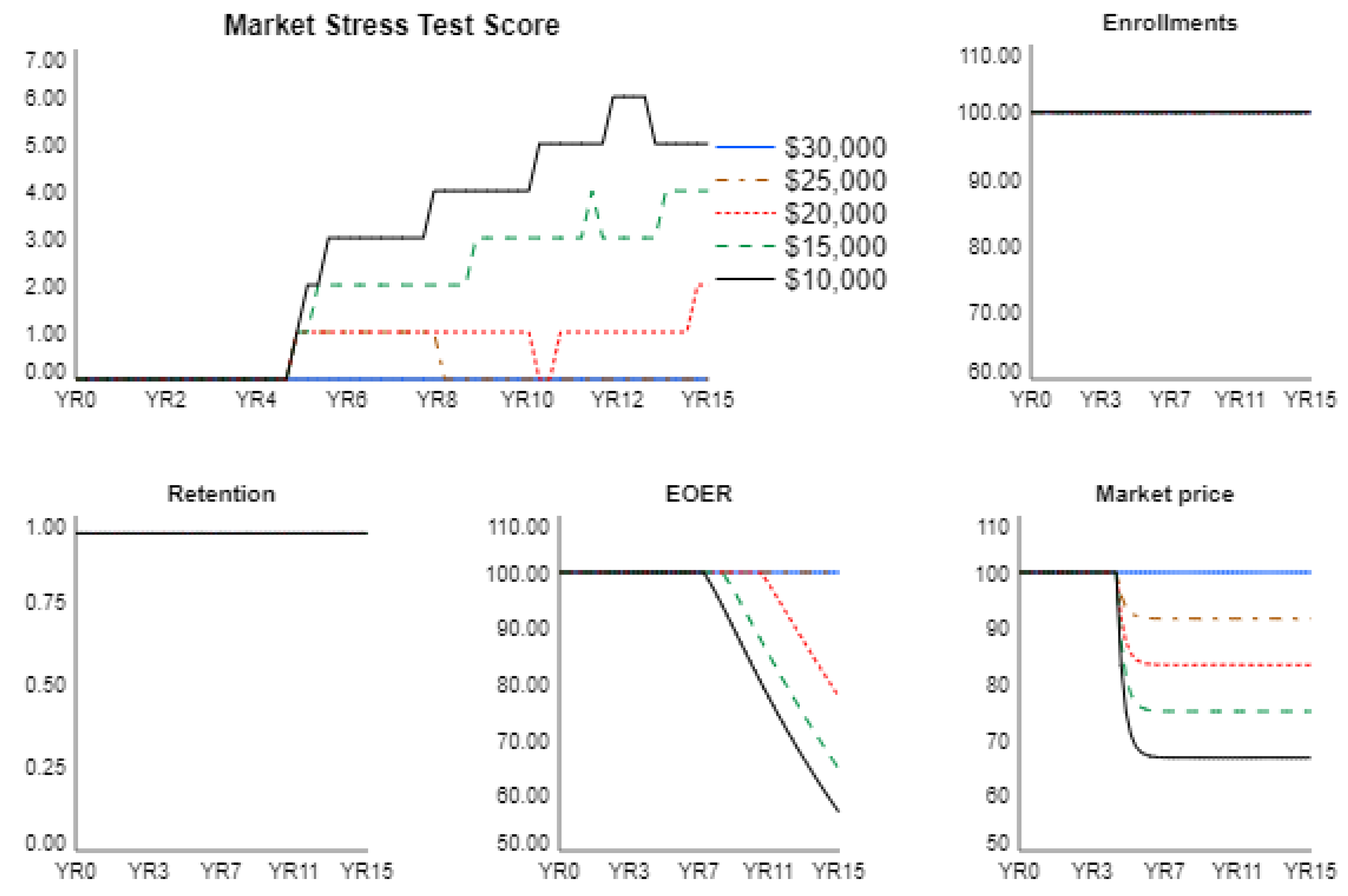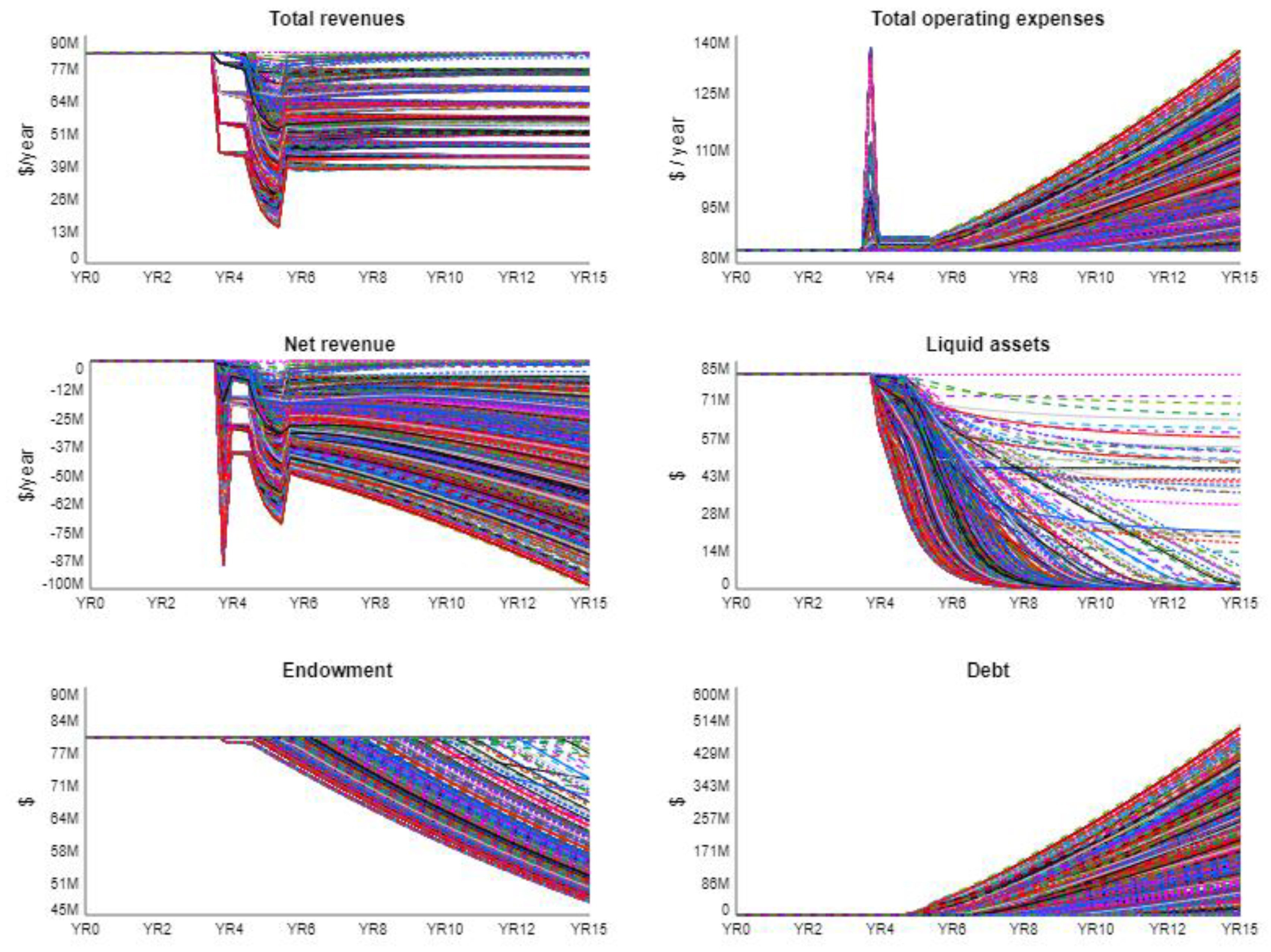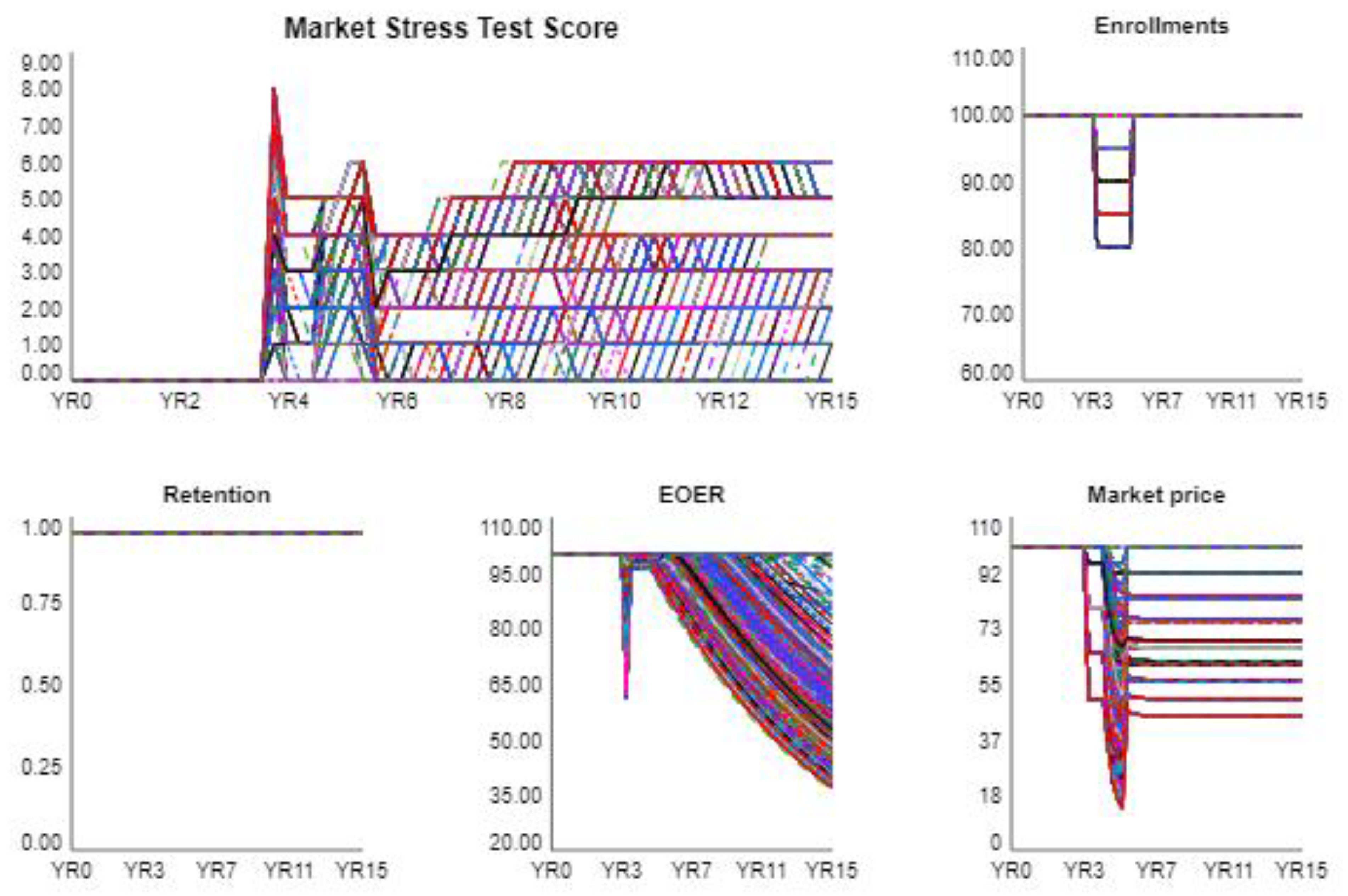Figure 1.
The four modules of the college model.
Figure 1.
The four modules of the college model.
Figure 2.
Six components of the COVID-19 shock that are studied in this article and their impact on a college.
Figure 2.
Six components of the COVID-19 shock that are studied in this article and their impact on a college.
Figure 3.
The dynamics of fewer students on campus (S1). The base case is when 100 percent of students remain on campus. We simulate four scenarios when 90, 60, 30, and 0 percent of student stay on campus.
Figure 3.
The dynamics of fewer students on campus (S1). The base case is when 100 percent of students remain on campus. We simulate four scenarios when 90, 60, 30, and 0 percent of student stay on campus.
Figure 4.
Sensitivity runs for the market stress test score (MSTS) and its components when fewer students are on campus. The runs are scenarios when 100, 90, 60, 30, and 0 percent of students remain on campus.
Figure 4.
Sensitivity runs for the market stress test score (MSTS) and its components when fewer students are on campus. The runs are scenarios when 100, 90, 60, 30, and 0 percent of students remain on campus.
Figure 5.
The dynamics of enrollment decline (S2). We simulate a case when only a fraction of a typical incoming class of students enroll during the pandemic. The base case is compared to the scenarios when 95, 90, 85, and 80 percent of a regular class enroll.
Figure 5.
The dynamics of enrollment decline (S2). We simulate a case when only a fraction of a typical incoming class of students enroll during the pandemic. The base case is compared to the scenarios when 95, 90, 85, and 80 percent of a regular class enroll.
Figure 6.
The market stress test score and its components when enrollment declines (S2). The base case is compared to the scenarios when 95, 90, 85, and 80 percent of a regular class enroll.
Figure 6.
The market stress test score and its components when enrollment declines (S2). The base case is compared to the scenarios when 95, 90, 85, and 80 percent of a regular class enroll.
Figure 7.
The effect of COVID-19 preparedness (S3). These scenarios simulate a one-time expense by the college on COVID-19 preparedness measures. We assume that the cost of COVID-19 preparedness can be 4, 8, 16, or 32 $/sq ft, which is compared to the base case when the cost is 0 $/sq ft.
Figure 7.
The effect of COVID-19 preparedness (S3). These scenarios simulate a one-time expense by the college on COVID-19 preparedness measures. We assume that the cost of COVID-19 preparedness can be 4, 8, 16, or 32 $/sq ft, which is compared to the base case when the cost is 0 $/sq ft.
Figure 8.
Sensitivity runs for the market stress test score and its components to account for COVID-19 preparedness (S3). We assume that the cost of COVID-19 preparedness can be 4, 8, 16, or 32 $/sq ft, which is compared to the base case when the cost is 0 $/sq ft.
Figure 8.
Sensitivity runs for the market stress test score and its components to account for COVID-19 preparedness (S3). We assume that the cost of COVID-19 preparedness can be 4, 8, 16, or 32 $/sq ft, which is compared to the base case when the cost is 0 $/sq ft.
Figure 9.
Effects due to expenses associated with the health and safety measures (S4). We assume that all students are tested 16, 32, or 64 times a year. In the steady state, students are not tested (0 tests).
Figure 9.
Effects due to expenses associated with the health and safety measures (S4). We assume that all students are tested 16, 32, or 64 times a year. In the steady state, students are not tested (0 tests).
Figure 10.
The market stress test score and its components for health and safety runs (S4). We assume that all students are tested 16, 32, or 64 times a year. In the steady state, students are not tested (0 tests).
Figure 10.
The market stress test score and its components for health and safety runs (S4). We assume that all students are tested 16, 32, or 64 times a year. In the steady state, students are not tested (0 tests).
Figure 11.
The dynamics when more financial aid is allocated (S5). The simulations assume that the pre-pandemic steady state tuition discount rate is 40 percent. When financial aid increases, the tuition discount rates become 45, 50, 55, and 60 percent.
Figure 11.
The dynamics when more financial aid is allocated (S5). The simulations assume that the pre-pandemic steady state tuition discount rate is 40 percent. When financial aid increases, the tuition discount rates become 45, 50, 55, and 60 percent.
Figure 12.
The market stress test score and its components when more financial aid is allocated (S5). The simulations assume that the pre-pandemic steady state tuition discount rate is 40 percent. When financial aid increases, the tuition discount rates become 45, 50, 55, and 60 percent.
Figure 12.
The market stress test score and its components when more financial aid is allocated (S5). The simulations assume that the pre-pandemic steady state tuition discount rate is 40 percent. When financial aid increases, the tuition discount rates become 45, 50, 55, and 60 percent.
Figure 13.
The dynamics of lower tuition (S6). These experiments assume that the tuition is reduced to $25,000, $20,000, $15,000, $10,000, while the steady state tuition prior to the pandemic is $30,000.
Figure 13.
The dynamics of lower tuition (S6). These experiments assume that the tuition is reduced to $25,000, $20,000, $15,000, $10,000, while the steady state tuition prior to the pandemic is $30,000.
Figure 14.
The market stress test score and its components when tuition is reduced (S6). These experiments assume that the tuition is reduced to $25,000, $20,000, $15,000, $10,000, while the steady state tuition prior to the pandemic is $30,000.
Figure 14.
The market stress test score and its components when tuition is reduced (S6). These experiments assume that the tuition is reduced to $25,000, $20,000, $15,000, $10,000, while the steady state tuition prior to the pandemic is $30,000.
Figure 15.
Trajectories of key variables during the combined sensitivity runs. We conduct 1000 runs for different combinations of parameter values from within the ranges specified for simulations S1–S6. The parameter values are picked using the Latin Hypercube sampling method.
Figure 15.
Trajectories of key variables during the combined sensitivity runs. We conduct 1000 runs for different combinations of parameter values from within the ranges specified for simulations S1–S6. The parameter values are picked using the Latin Hypercube sampling method.
Figure 16.
The market stress test score and its components during the simulation of the combined effect of COVID-19 on an academic institution. We conduct 1000 runs for different combinations of parameter values from within the ranges specified for simulations S1–S6. The parameter values are picked using the Latin Hypercube sampling method.
Figure 16.
The market stress test score and its components during the simulation of the combined effect of COVID-19 on an academic institution. We conduct 1000 runs for different combinations of parameter values from within the ranges specified for simulations S1–S6. The parameter values are picked using the Latin Hypercube sampling method.
Table 1.
Market stress test score (MSTS) calculation.
Table 1.
Market stress test score (MSTS) calculation.
| Component | Value is Less than the Alert Level | Value is Less than the Warning Level | Trend is Negative and Absolute Value is Greater than 1 Percent |
|---|
| First-year enrollment | +1 | +1 | +1 |
| Retention | +1 | +1 | +1 |
| Market price | +1 | +1 | +1 |
| Endowment-to-expense ratio | +1 | +1 | +1 |
Table 2.
The effect of fewer students on campus (S1). M = millions. K = thousands.
Table 2.
The effect of fewer students on campus (S1). M = millions. K = thousands.
| | Indicators (Units) | Share of Students on Campus, % |
|---|
| | 100 | 90 | 60 | 30 | 0 |
|---|
| Short-term (YR5) | Incoming class (students) | 600 | 600 | 600 | 600 | 600 |
| Students on campus (students) | 2204 | 1984 | 1322 | 661 | 0 |
| Net room and board ($/year) | 40 M | 36 M | 24 M | 12 M | 0 M |
| Total operating expenses ($/year) | 83 M | 83 M | 83 M | 83 M | 83 M |
| Net revenue ($/year) | 0 | −4 M | −16 M | −28 M | −40 M |
| Liquid assets ($) | 80 M | 76 M | 64 M | 52 M | 40 M |
| Endowment ($) | 80 M | 80 M | 80 M | 80 M | 80 M |
| Debt ($) | 0 | 0 | 0 | 0 | 0 |
| Market Stress Test Score | 0 | 1 | 2 | 3 | 3 |
| Long-term (YR13) | Incoming class (students) | 600 | 600 | 600 | 600 | 600 |
| Students on campus (students) | 2204 | 2204 | 2204 | 2204 | 2204 |
| Net room and board ($/year) | 40 M | 40 M | 40 M | 40 M | 40 M |
| Total operating expenses ($/year) | 83 M | 83 M | 83 M | 83 M | 83 M |
| Net revenue ($/year) | 0 | 0 | 0 | 0 | −768 K |
| Liquid assets ($) | 80 M | 72 M | 48 M | 24 M | 6 M |
| Endowment ($) | 80 M | 80 M | 80 M | 80 M | 77 M |
| Debt ($) | 0 | 0 | 0 | 0 | 6 M |
| Market Stress Test Score | 0 | 0 | 0 | 0 | 0 |
Table 3.
The effect of enrollment decline (S2). M = millions. K = thousands.
Table 3.
The effect of enrollment decline (S2). M = millions. K = thousands.
| | Indicators (Units) | Fraction of Incoming Class, % |
|---|
| | 100 | 95 | 90 | 85 | 80 |
|---|
| Short-term (YR5) | Incoming class (students) | 600 | 570 | 540 | 510 | 480 |
| Students on campus (students) | 2204 | 2177 | 2150 | 2123 | 2096 |
| Net room and board ($/year) | 40 M | 39 M | 39 M | 38 M | 38 M |
| Total operating expenses ($/year) | 83 M | 83 M | 83 M | 83 M | 83 M |
| Net revenue ($/year) | 0 | −1 M | −2 M | −3 M | −4 M |
| Liquid assets ($) | 80 M | 79.6 M | 79.2 M | 78.8 M | 78.4 M |
| Endowment ($) | 80 M | 80 M | 80 M | 80 M | 80 M |
| Debt ($) | 0 | 0 | 0 | 0 | 0 |
| Market Stress Test Score | 0 | 1 | 1 | 1 | 2 |
| Long-term (YR13) | Incoming class (students) | 600 | 600 | 600 | 600 | 600 |
| Students on campus (students) | 2204 | 2197 | 2191 | 2184 | 2177 |
| Net room and board ($/year) | 40 M | 40 M | 39 M | 39 M | 39 M |
| Total operating expenses ($/year) | 83 M | 83 M | 83 M | 83 M | 83 M |
| Net revenue ($/year) | 0 | −0.2 M | −0.5 M | −0.7 M | −1 M |
| Liquid assets ($) | 80 M | 72.9 M | 65.9 M | 58.8 M | 51.7 M |
| Endowment ($) | 80 M | 80 M | 80 M | 80 M | 80 M |
| Debt ($) | 0 | 0 | 0 | 0 | 0 |
| Market Stress Test Score | 0 | 0 | 0 | 0 | 0 |
Table 4.
The effect of COVID-19 preparedness (S3). M = millions. K = thousands.
Table 4.
The effect of COVID-19 preparedness (S3). M = millions. K = thousands.
| | Indicators (Units) | Cost of Preparedness, $/sq ft |
|---|
| | 0 | 4 | 8 | 16 | 32 |
|---|
| Short-term (YR4) | Incoming class (students) | 600 | 600 | 600 | 600 | 600 |
| Students on campus (students) | 2204 | 2204 | 2204 | 2204 | 2204 |
| Net room and board ($/year) | 40 M | 40 M | 40 M | 40 M | 40 M |
| Total operating expenses ($/year) | 83 M | 89.6 M | 95.8 M | 108 M | 133 M |
| Net revenue ($/year) | 0 | −6.3 M | −12.5 M | −25 M | −50 M |
| Liquid assets ($) | 80 M | 80 M | 80 M | 80 M | 80 M |
| Endowment ($) | 80 M | 80 M | 80 M | 80 M | 80 M |
| Debt ($) | 0 | 0 | 0 | 0 | 0 |
| Market Stress Test Score | 0 | 1 | 1 | 2 | 3 |
| Long-term (YR13) | Incoming class (students) | 600 | 600 | 600 | 600 | 600 |
| Students on campus (students) | 2204 | 2204 | 2204 | 2204 | 2204 |
| Net room and board ($/year) | 40 M | 40 M | 40 M | 40 M | 40 M |
| Total operating expenses ($/year) | 83 M | 83 M | 83 M | 83 M | 83 M |
| Net revenue ($/year) | 0 | 0 | 0 | 0 | 0 |
| Liquid assets ($) | 80 M | 78.4 M | 76.9 M | 73.8 M | 67.5 M |
| Endowment ($) | 80 M | 80 M | 80 M | 80 M | 80 M |
| Debt ($) | 0 | 0 | 0 | 0 | 0 |
| Market Stress Test Score | 0 | 0 | 0 | 0 | 0 |
Table 5.
The effect of health and safety measures (S4). M = millions. K = thousands.
Table 5.
The effect of health and safety measures (S4). M = millions. K = thousands.
| | Indicators (Units) | COVID-19 Testing, Times/yr |
|---|
| | 0 | 16 | 32 | 64 |
|---|
| Short-term (YR4) | Incoming class (students) | 600 | 600 | 600 | 600 |
| Students on campus (students) | 2204 | 2204 | 2204 | 2204 |
| Net room and board ($/year) | 40 M | 40 M | 40 M | 40 M |
| Total operating expenses ($/year) | 83 M | 84 M | 85 M | 87 M |
| Net revenue ($/year) | 0 | −1 M | −1.8 M | −3.5 |
| Liquid assets ($) | 80 M | 79 M | 78 M | 76 M |
| Endowment ($) | 80 M | 80 M | 80 M | 80 M |
| Debt ($) | 0 | 0 | 0 | 0 |
| Market Stress Test Score | 0 | 0 | 0 | 1 |
| Long-term (YR13) | Incoming class (students) | 600 | 600 | 600 | 600 |
| Students on campus (students) | 2204 | 2204 | 2204 | 2204 |
| Net room and board ($/year) | 40 M | 40 M | 40 M | 40 M |
| Total operating expenses ($/year) | 83 M | 83 M | 83 M | 83 M |
| Net revenue ($/year) | 0 | 0 | 0 | 0 |
| Liquid assets ($) | 80 M | 78 M | 76 M | 73 M |
| Endowment ($) | 80 M | 80 M | 80 M | 80 M |
| Debt ($) | 0 | 0 | 0 | 0 |
| Market Stress Test Score | 0 | 0 | 0 | 0 |
Table 6.
The effect of greater financial aid (S5). M = millions. K = thousands.
Table 6.
The effect of greater financial aid (S5). M = millions. K = thousands.
| | Indicators (Units) | Tuition Discount Rate, % |
|---|
| | 40 | 45 | 50 | 55 | 60 |
|---|
| Short-term (YR5) | Incoming class (students) | 600 | 600 | 600 | 600 | 600 |
| Students on campus (students) | 2204 | 2204 | 2204 | 2204 | 2204 |
| Net room and board ($/year) | 40 M | 36 M | 33 M | 30 M | 26 M |
| Total operating expenses ($/year) | 83 M | 83 M | 83 M | 83 M | 83 M |
| Net revenue ($/year) | 0 | −6.6 M | −13.2 M | −19.8 M | −26.4 M |
| Liquid assets ($) | 80 M | 80 M | 80 M | 80 M | 80 M |
| Endowment ($) | 80 M | 80 M | 80 M | 80 M | 80 M |
| Debt ($) | 0 | 0 | 0 | 0 | 0 |
| Market Stress Test Score | 0 | 1 | 1 | 2 | 3 |
| Long-term (YR13) | Incoming class (students) | 600 | 600 | 600 | 600 | 600 |
| Students on campus (students) | 2204 | 2204 | 2204 | 2204 | 2204 |
| Net room and board ($/year) | 40 M | 36 M | 33 M | 30 M | 26 M |
| Total operating expenses ($/year) | 83 M | 83 M | 85 M | 91 M | 97 M |
| Net revenue ($/year) | 0 | −6.6 M | −15.6 M | −28 M | −40.8 M |
| Liquid assets ($) | 80 M | 27.1 M | 0.4 M | 66 K | 27 K |
| Endowment ($) | 80 M | 80 M | 70 M | 63 M | 60 M |
| Debt ($) | 0 | 0 | 17 M | 69 M | 126 M |
| Market Stress Test Score | 0 | 0 | 1 | 3 | 5 |
Table 7.
The effect of lower tuition (S6). M = millions. K = thousands.
Table 7.
The effect of lower tuition (S6). M = millions. K = thousands.
| | Indicators (Units) | Tuition, $ |
|---|
| | 30 K | 25 K | 20 K | 15 K | 10 K |
|---|
| Short-term (YR6) | Incoming class (students) | 600 | 600 | 600 | 600 | 600 |
| Students on campus (students) | 2204 | 2204 | 2204 | 2204 | 2204 |
| Net room and board ($/year) | 40 M | 40 M | 40 M | 40 M | 40 M |
| Total operating expenses ($/year) | 83 M | 83 M | 83 M | 83 M | 83 M |
| Net revenue ($/year) | 0 | −6 M | −12.4 M | −18.6 M | −24.8 M |
| Liquid assets ($) | 80 M | 76.5 M | 73 M | 69.5 M | 66 M |
| Endowment ($) | 80 M | 80 M | 80 M | 80 M | 80 M |
| Debt ($) | 0 | 0 | 0 | 0 | 0 |
| Market Stress Test Score | 0 | 0 | 0 | 0 | 0 |
| Long-term (YR13) | Incoming class (students) | 600 | 600 | 600 | 600 | 600 |
| Students on campus (students) | 2204 | 2204 | 2204 | 2204 | 2204 |
| Net room and board ($/year) | 40 M | 40 M | 40 M | 40 M | 40 M |
| Total operating expenses ($/year) | 83 M | 83 M | 84.7 M | 89.6 M | 95.2 M |
| Net revenue ($/year) | 0 | −6.6 M | −15 M | −26.9 M | −39.3 M |
| Liquid assets ($) | 80 M | 30.4 M | 794 K | 117 K | 49 K |
| Endowment ($) | 80 M | 80 M | 71.7 M | 64.6 M | 61.4 M |
| Debt ($) | 0 | 0 | 12 M | 59 M | 111 M |
| Market Stress Test Score | 0 | 0 | 1 | 3 | 6 |
